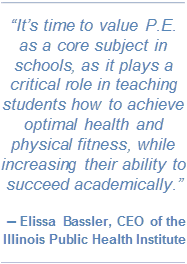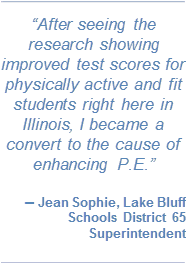 SPRINGFIELD – A state report released today calls for new benchmarks and strategies to improve and increase physical education classes, noting the latest neuroscience research linking physical activity with improved academic performance. State Superintendent of Education Christopher A. Koch and Dr. LaMar Hasbrouck, director of the Department of Public Health, co-chaired the Illinois Enhance Physical Education (P.E.) Task Force, which developed the 148-page report that has been submitted to Gov. Pat Quinn, the Illinois State General Assembly, and health organizations and community groups interested in turning the tide of childhood obesity and improving health for all students.
SPRINGFIELD – A state report released today calls for new benchmarks and strategies to improve and increase physical education classes, noting the latest neuroscience research linking physical activity with improved academic performance. State Superintendent of Education Christopher A. Koch and Dr. LaMar Hasbrouck, director of the Department of Public Health, co-chaired the Illinois Enhance Physical Education (P.E.) Task Force, which developed the 148-page report that has been submitted to Gov. Pat Quinn, the Illinois State General Assembly, and health organizations and community groups interested in turning the tide of childhood obesity and improving health for all students.
“There are no silver bullet options when it comes to solutions to the most pressing issues facing our students today,” said State Superintendent of Education Koch. “There is compelling research, however, that shows Illinois students with healthy levels of cardiorespiratory fitness were more than two times more likely to meet state testing standards in reading and math. Increasing physical activity during the school day is a critical and attainable way to improve student health and academic outcomes in the near term.”
Illinois’ schools system, like those in many states, faces multiple challenges, including budgetary and facility constraints as well as soaring obesity rates – all of which disproportionately impact low-income and minority populations.
Enhanced physical education is an evidence-based approach that calls for increasing the amount of time students spend in moderate to vigorous physical activity in P.E. class and has generated proven positive results.
The Illinois Enhance Physical Education Task Force reviewed extensive research showing that children who are more physically active – in P.E. class, throughout the school day and during recess – perform better in class and on standardized tests, exhibit better classroom behaviors and improve health outcomes.
The recommended standards and strategies could be implemented in the coming years and could mean new approaches to P.E., such as integrating physical activity throughout the school day, to reap even more benefits.
Quality enhanced P.E. programs ensure that at least 50 percent of a class time is spent in moderate to vigorous activity. National research, however, shows that the time being spent physically active during P.E. classes is generally low. In a typical 30-minute K-6 class, students engage in only about 11 minutes of physical activity per day. Illinois, the first state in the nation to require daily P.E. for all K-12 students, has seen several schools, such as those in Lake Bluff, Naperville and Unity Point, already change their focus, emphasizing fitness over athletics or team sports, and more schools may take a similar approach in the coming years.
To see a chart outlining the differences between traditional P.E. and enhanced P.E. approaches, go to
http://www.isbe.net/EPE/pdf/reports-webinars/epetf-pe-comparison-chart0813.pdf.
In order to increase P.E.’s return on investment for learning and health, the governor signed Public Act 97-1102 in August 2012, creating the Enhance P.E. Task Force. Per its charge, the task force proposed revisions to Goals 19-24 of the Illinois Learning Standards for Physical Development and Health, including the addition of two new standards that incorporate the latest research and best practices for achieving optimal student health and academic achievement.
One proposed new standard covers advocating for the health of individuals, families and communities and another calls for explaining the structures and functions of the brain and how they are impacted by different physical activities and fitness levels. Learning standards are set at the state level while districts then write curricula to meet the standards.
In addition to the task force’s expertise, the revisions were reviewed by more than a dozen experts across Illinois. The task force expects that the regulatory review process, including the Illinois State Board of Education’s review and possible adoption of the proposed standards, public comment and approval by the Joint Committee on Administrative Rules, will occur during the 2013-2014 school year.
School officials could begin planning for and phasing in implementation of the new standards during the 2014-2015 academic year and would be ready for full implementation of the standards in the 2015-16 academic year.
 The task force convened more than 30 school, physical education, and health experts and stakeholders from across the state.
The task force convened more than 30 school, physical education, and health experts and stakeholders from across the state.
“I came to this work from a place of caution,” said Jean Sophie, superintendent of Lake Bluff Schools District 65 and member of the task force. “As a school superintendent, I’m keenly aware of the pressure schools are facing to meet new requirements. After seeing the research showing improved test scores for physically active and fit students right here in Illinois, I became a convert to the cause of enhancing P.E. We worked hard to offer a comprehensive set of recommendations that take into account the geographic, demographic and economic diversity of the state’s 860 school districts.”
The report provides a rationale for why physical education is critical given our current fiscal climate and health outcomes, and offers guidance and resources for achieving better academic performance, improved behavior and better health.
“Healthy children are better learners. Improving student fitness and health is a key goal of the Illinois Department of Public Health in our statewide `We Choose Health initiative,’ because we understand that there are lifelong benefits – in terms of less chronic disease and lower costs to the health care system,” said Dr. Hasbrouck. “This report offers practical, implementable and feasible approaches to enhancing P.E. programs right now.”
The recommendations offer an array of strategies to enhance existing P.E. programs, including:
- Promoting training and professional development in enhanced P.E. for teachers and other school and community stakeholders.
- Implementing metrics to assess the impact of enhanced physical education.
- Identifying and seeking local, state and national resources to support enhanced physical education.
- Engaging communities.
For more information on the Enhance P.E. Task Force, and to read the task force’s full report, visit
http://www.isbe.net/EPE/html/EPETF.htm. The Illinois State Board of Education and the Illinois Department of Public Health will continue discussions with members of the task force to increase awareness of the need and the resources available for implementing enhanced physical education.
“It’s time to value P.E. as a core subject in schools, as it plays a critical role in teaching students how to achieve optimal health and physical fitness, while increasing their ability to succeed academically,” said Elissa Bassler, task force member and CEO of the Illinois Public Health Institute. “As health advocates, we also know that better education correlates with better health, so we see this work as a win-win for both education and health.”
